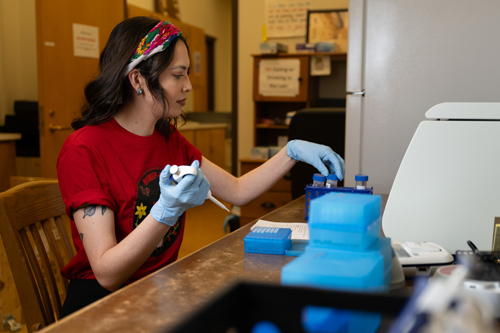Michelle Newcomeris a research scientist in Berkeley Lab’s Earth & Environmental Sciences Area with expertise in hydrological and biogeochemical aspects of environmental issues, especially in watersheds and river environments. In her research she has investigated the links between microbial activity and larger scale effects, such as changes in the climate system. One of her recent projectslooked at how the 2017 Sonoma County wildfires in Northern California affected water availability and water quality.
Now she is turning her expertise to algal blooms, which can occur in both the sea and freshwater. Harmful and nuisance algal blooms are thought to have a number of contributing causal factors, including a build-up of nutrients (such as from fertilizer run-off), unusually high water temperatures, and extreme weather events such as floods and drought, according to the National Oceanic and Atmospheric Administration, which tries to forecast blooms. But an understanding of the connectivity between these triggers is missing, as is an ability to predict the onset of the blooms.
Q. What do we know about the causes of harmful algal blooms, and how is your research approach different?
A. Many factors attributed to blooms are known, such as nutrients, however much research is needed to examine the causal linkages between environmental and terrestrial factors contributing to both nuisance and toxic blooms. While scientists know that specific nutrients are needed to support algae growth, there are also circumstances where you have nutrient-limited conditions, yet algae will still grow. So there are various complicating factors that still need a lot of research. How do we unravel and differentiate between all the different factors that control algae in unique and nonlinear ways?
With algae, there’s a lot of really interesting research being done around food webs in flowing waters. Terrestrial-aquatic systems include interactions between surface water and groundwater, nutrients, microbes, insects, fish, birds, and algae. When one component is disrupted, it impacts others because it’s a complete web of interactions.
One researcher in the Great Lakes region, for example, discovered that road salt was linked to the reduction in mouth-size of a grazing insect important for consuming harmful algae, and this new limitation was identified as a primary causal factor of increased bloom occurrence. In California, drought conditions have been linked to freshwater cyanobacterial blooms – not because of warm, dry summers, but rather because of the absence of storms associated with atmospheric rivers during spring. These are very nonlinear systems where nutrient-bloom relationships often rely on third- and fourth- order causal factors across entire watersheds.
Our new “big idea” is to examine this from a holistic perspective, considering the entire watershed, which governs the transport of nutrients and solutes, as well as dynamics across important biogeochemical interfaces that interact with waterways. Because rivers flow through these landscapes, the terrestrial environment is continuously interacting with the aquatic compartment of a watershed system. As rivers flow downstream, they export nutrients, solutes, metals, and algae communities from upstream to the ocean.
In my research I’m trying to link river nutrients and the river food web supported by landscapes to coastal and inland aquatic blooms.
We believe that watersheds – and coastal watersheds in particular – are very important units for delivery of water and nutrients to the ocean. We also recognize that weather and climate will have an impact on the algal bloom downstream because the magnitude and frequency of precipitation events will influence the hydrobiogeochemical partitioning of water and nutrients that drives the onset of algal blooms.
Q. So will a warmer climate mean more blooms?
A. We’re not sure yet. The scientific literature often points to the expectation of a warmer and dryer future climate, meaning less rain delivery to these watersheds. That will reduce riverbed turnover, which is a critical factor in stabilizing healthy food-web and algal systems, with the potential that some hazardous algal bloom species may dominate blooms more often.
Our main hypothesis is directly linked to river flow: when a high flow event occurs that turns over those riverbed sediments and mixes everything up, it creates a new fresh system. It’s an important mechanism for resetting those systems – it’s like a fresh clean state. When “resets” happen less often, those systems are more susceptible to disequilibrium, allowing one algal strain to dominate for a long time. So river turnover is important, as it can reset the system.
Conventional wisdom holds that nutrients are the main and only cause of blooms. Our work challenges that assumption and requires us to think about other factors that have a potentially more definitive role in tilting watersheds towards algal degradation. For example, we are testing a completely new concept that extreme events, such as atmospheric rivers, can greatly perturb watersheds and potentially play an important role in the onset of algal blooms.
Q. How are you conducting your research?
A. We’re looking at things like the flow conditions of the watershed, so that includes looking at the river discharge, as well as the nutrients, solutes, and metals, such as phosphorous, nitrogen, silica, and iron, that’s exiting watersheds. These can come from natural processes within the watershed, and oftentimes there’s runoff and groundwater baseflow contributing to background concentrations. We are taking a novel, machine-learning approach to examining the watershed concentration-discharge conditions contributing to blooms.
We’re also using the new PhycoProbe sensor to continuously measure different phytoplanktonalgal taxonomic groups within the water column, providing us a really nice time series of the different groups, including times when one group emerges and when another one decays. So we’ll know when one becomes dominant and at which point in time.
There are thousands of different species of algae. Only a very small percentage of them are harmful, and an even smaller percentage produce toxins. Some have the ability to produce toxins, but they don’t for reasons beyond the scope of our study.
Q. What is your end goal in this research?
A. Our goal is to develop capabilities to predict the onset of algal blooms from coupling our understanding about algae, watershed processes, and climate, and to identify precursor signals using simple datasets. We don’t yet know what that signal could be, but we’re analyzing for any kind of signal that would indicate a harmful algal bloom is about to happen.
Developing a model that accurately predicts the onset of algae blooms and is useful to stakeholders must be based on an adequate understanding of the complex, coupled processes that describe precursors of blooms. We can then use that model to develop science-based mitigation or remediation capabilities, where, for example, a species of harmless algae, one that is helpful to the ecosystem, may be deployed to dominate over a harmful one. We currently don’t adequately understand the dynamics very well of how different species interact, but I do see that as a way forward.
# # #
Founded in 1931 on the belief that the biggest scientific challenges are best addressed by teams, Lawrence Berkeley National Laboratoryand its scientists have been recognized with 13 Nobel Prizes. Today, Berkeley Lab researchers develop sustainable energy and environmental solutions, create useful new materials, advance the frontiers of computing, and probe the mysteries of life, matter, and the universe. Scientists from around the world rely on the Lab’s facilities for their own discovery science. Berkeley Lab is a multiprogram national laboratory, managed by the University of California for the U.S. Department of Energy’s Office of Science.
DOE’s Office of Science is the single largest supporter of basic research in the physical sciences in the United States, and is working to address some of the most pressing challenges of our time. For more information, please visit energy.gov/science.
scraped from https://www.newswise.com/articles/tiny-toxins-how-algal-blooms-affect-coastal-systems-through-a-complex-web-of-interactions



